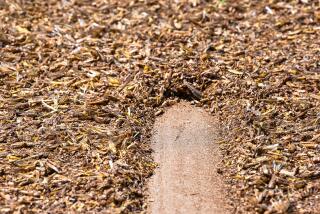Plague of Pests Predicted in Parched Utah
- Share via
SALT LAKE CITY — Parched lawns and short showers may be the least of Utah’s worries as the state moves through the fifth year of a debilitating drought.
Wildlife officials are predicting that the dry stretch will create hordes of thirsty crickets, an onslaught of drought-tolerant but highly flammable grass and predatory beetles that could wipe out acres of pine forests.
The combination of pests has state officials alarmed over the potential ecological impact, which could last far longer than the drought itself.
In the last two years, what has seemed like a population explosion for Mormon crickets and grasshoppers is a result of their move from drought-stricken range toward areas that provide food and water, said Ed Bianco, entomologist with the Utah Department of Agriculture.
“They’re moving into our cultivated and agricultural areas when they can’t find food elsewhere,” he said. “It seems like all these insects are congregating in one spot, but they aren’t; they are just going to the food.”
Early season surveys show an increase in the numbers of Mormon crickets, Bianco said, although it is still too early to get a good impression of grasshopper numbers.
His surveys turned up another pest with the potential to take a toll on plant life. Army cutworms -- caterpillars that will turn into moths -- will eat any green vegetation in their path. The Department of Agriculture is using state and federal funds to try to stamp out the bugs.
The first week of April, the USDA started applying bait in central Utah, said Larry Lewis, spokesman for the Utah Department of Agriculture. “It’s really effective. The crickets walk through it and consume it, and they’re dead within 10 minutes.”
Another problem is nonnative cheatgrass, which thrives in drought and is choking an entire ecosystem within the Utah range, overwhelming sagebrush and the various plants found in a sagebrush-steppe habitat. It has quickly taken over acres of range land and offers none of the habitat or nutritional value needed to sustain animals.
The plant is the “fire-carrying, tan-colored, competitive plant scourge of the West,” said Bill James, a manager in the habitat section of the Utah Division of Wildlife Resources.
Affected wildlife include mule deer, various species of sage grouse and sparrow, the sagebrush lizard, some hawks and the pygmy rabbit -- which has been petitioned for inclusion on the federal threatened and endangered species list, he said.
“Unfortunately for some of the higher life forms, they can’t move as easily as a Mormon cricket,” James said. “We’re talking about an ecosystem that’s in trouble. Even if the meteorological aspects of the drought were to recover tomorrow, there would need to be several years of recovery.”
James’ division has restored between 10,000 and 15,000 acres of land infested with the grass each year.
In addition to destroying habitat, the grass burns hotter than perennial native grasses, James said, making it a dangerous fuel for wildfire.
Also contributing to the fire danger are trees infested with various types of pine beetle. The spruce bark beetle has killed a large area of the forest, and drought and wind damage aided the destruction, said Frances Reynolds, spokeswoman for Dixie National Forest.
Thirsting trees can’t produce much sap, which can help deter the bugs. Dead trees offer no resistance to fire.
“It’s a beetle that killed those trees and that contributes to our concerns for the upcoming fire season,” Reynolds said.
More to Read
Sign up for Essential California
The most important California stories and recommendations in your inbox every morning.
You may occasionally receive promotional content from the Los Angeles Times.













